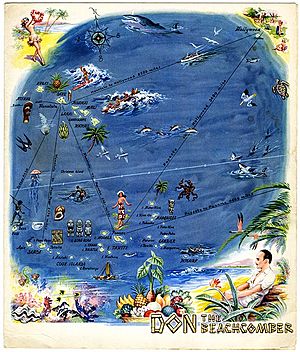Donn Beach facts for kids
Quick facts for kids
Donn Beach
|
|
|---|---|
| Born |
Ernest Raymond Gantt
February 22, 1907 Limestone County, Texas, U.S.
|
| Died | June 7, 1989 (aged 82) Honolulu, Hawaii, U.S.
|
| Resting place | National Memorial Cemetery of the Pacific |
| Other names | Don Gantt, Don E.R.G. Beach-Comber, Donn E.R.G. Beach |
| Spouse(s) | Cora Irene "Sunny" Sund, Carla Dupree, Phoebe Beach |
| Military career | |
| Allegiance | United States |
| Service/ |
United States Army Air Forces |
| Years of service | 1942-1945 |
| Rank | Lt Col |
| Service number | AO 904 870 |
| Awards |
|
Donn Beach (born Ernest Raymond Gantt; February 22, 1907 – June 7, 1989) was an American adventurer and businessman. He is known as the "founding father" of tiki culture, which is a fun style inspired by tropical islands.
He opened the very first tiki bar, called Don the Beachcomber, in the 1930s in Hollywood, California. This bar became so popular that it grew into a chain of many restaurants across the United States. Later, he moved to Hawaii and created the International Market Place. Donn Beach was also a veteran of World War II.
Contents
Early Adventures
Ernest Raymond Gantt was born in 1907. He spent his early school days in places like Mandeville, Louisiana, Jamaica, and Texas. When he was 16, he started working with his mother, who ran boarding houses.
At age 20, he left home to travel the world. He worked on a yacht going to Australia, stopping in Hawaii along the way. He then spent more time exploring islands in the South Pacific. Donn Beach was known for telling exciting stories about his travels.
Starting Don the Beachcomber
In 1933, a law called Prohibition ended in the U.S. This law had made it illegal to sell alcohol. Once it ended, Ernest opened a bar in Hollywood called "Don's Beachcomber." It quickly became very popular.
Because of his bar's success, he started calling himself Don the Beachcomber. He even legally changed his name to Donn Beach. In 1937, his bar moved to a bigger spot and became a restaurant. He decorated it with bamboo and items from his travels, making it feel like a tropical island getaway. He even had sounds of fake rain to add to the atmosphere! His motto was, "If you can't get to paradise, I'll bring it to you!"
Donn Beach was famous for creating many unique rum cocktails. He called them "Rhum Rhapsodies." One of his most famous drinks was the Zombie cocktail. He also invented many others, like the Cobra's Fang, Tahitian Rum Punch, and Navy Grog. His menus sometimes featured 60 different drinks!
Since restaurants had to serve food after Prohibition, Donn Beach offered what he called "South Seas Island food." This was mostly Chinese dishes served in a fun, exotic way. He is also credited with creating the first pu pu platter, which is a tray of different appetizers.
His restaurant was a big hit with Hollywood stars. Many famous actors, like Marlene Dietrich and Bing Crosby, became regular customers. Donn made them feel special by giving them personalized bamboo chopstick cases.
In the 1930s, Donn married Sunny Sund, who was a waitress. She became his business partner and helped make the restaurant even bigger and more professional. They later divorced in 1940.
Serving in World War II
During World War II, Donn Beach served as a Lieutenant Colonel in the United States Army Air Forces. He was awarded a Purple Heart after being injured during a submarine attack on a ship.
After he recovered, he helped set up rest and recreation centers for officers. He even created new cocktail names inspired by the Air Corps, like the Q.B. Cooler and the Test Pilot. He also received the Bronze Star for setting up rest camps for tired airmen in places like Capri and Venice, Italy.
Tiki Craze After the War
After World War II, tiki-themed restaurants and bars became hugely popular. Donn Beach's former wife, Sunny Sund, continued to manage and expand the Don the Beachcomber chain. At its peak, there were 16 locations across the country.
Another famous tiki restaurant owner, Victor J. Bergeron (who created Trader Vic's), was a friendly rival of Donn Beach. They both claimed to have invented the Mai Tai, a very popular rum and fruit-juice drink.
Donn Beach also created his own "Polynesian Village" at his ranch in California. Here, he hosted amazing luaus, which are traditional Hawaiian parties, for many Hollywood celebrities.
Moving to Hawaii
In 1945, Donn Beach decided to move to the Territory of Hawaii. He continued to create fun, tiki-themed businesses there. He settled in Waikiki and opened his second "Polynesian Village," known as Waikiki Village.
He was the creator of the International Market Place. For this project, he even set up his offices in the branches of a giant banyan tree in the market's center. The village was filled with thatch huts and wood carvings. The International Market Place also featured a bar and more Don the Beachcomber restaurants.
The market was very successful, and Donn Beach's work greatly helped tourism in Hawaii. He was even honored with a special award in 1957 for his contributions. He also helped create laws to protect historic places in Hawaii. At its busiest, the International Market Place had 50 shops, nightclubs, and restaurants.
Donn Beach married two more times. He later moved to Moorea and lived on an elaborate houseboat for several years. In 1989, he died from an illness and was buried in the National Memorial Cemetery of the Pacific in Honolulu. His legacy lives on through the tiki culture he helped create.


